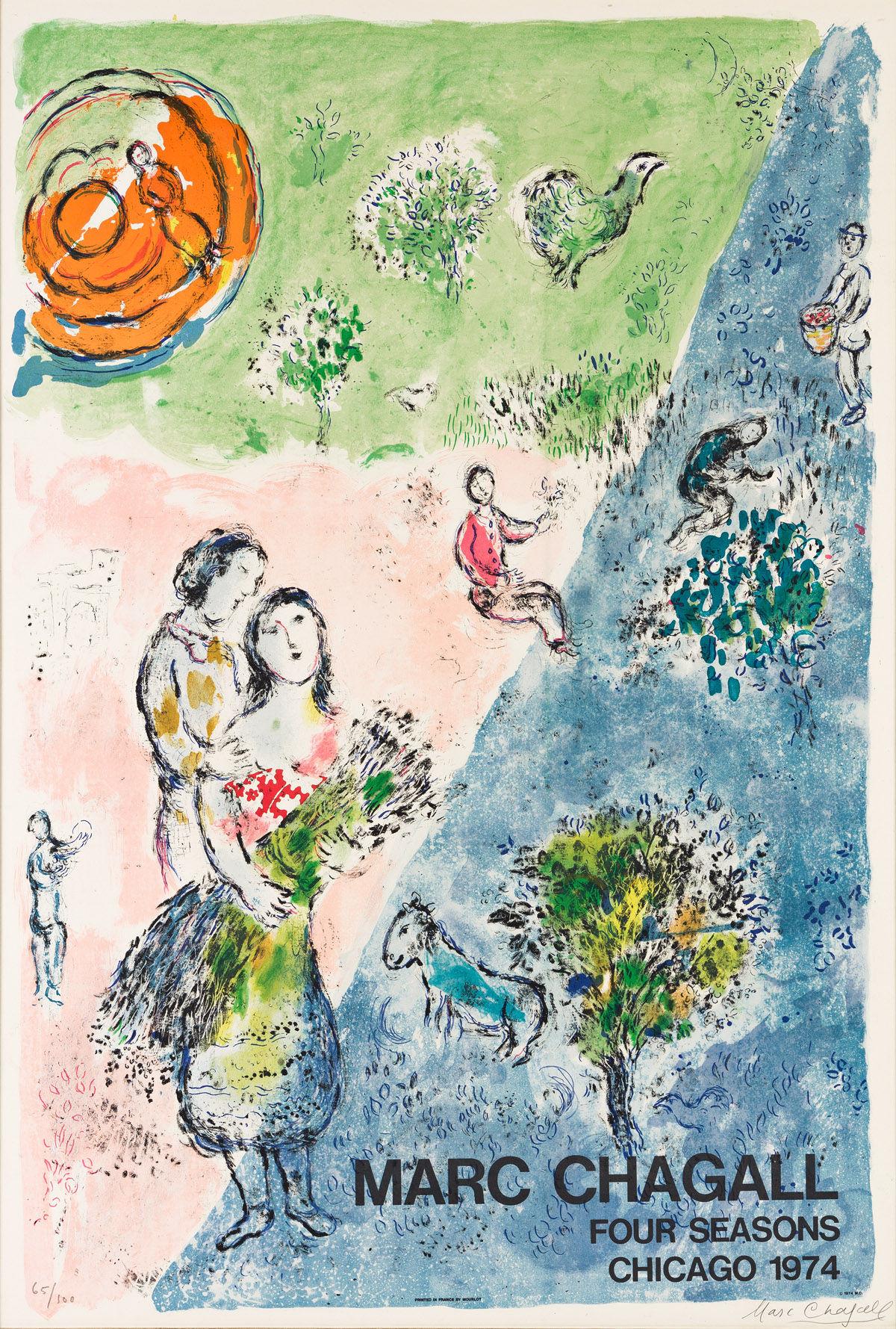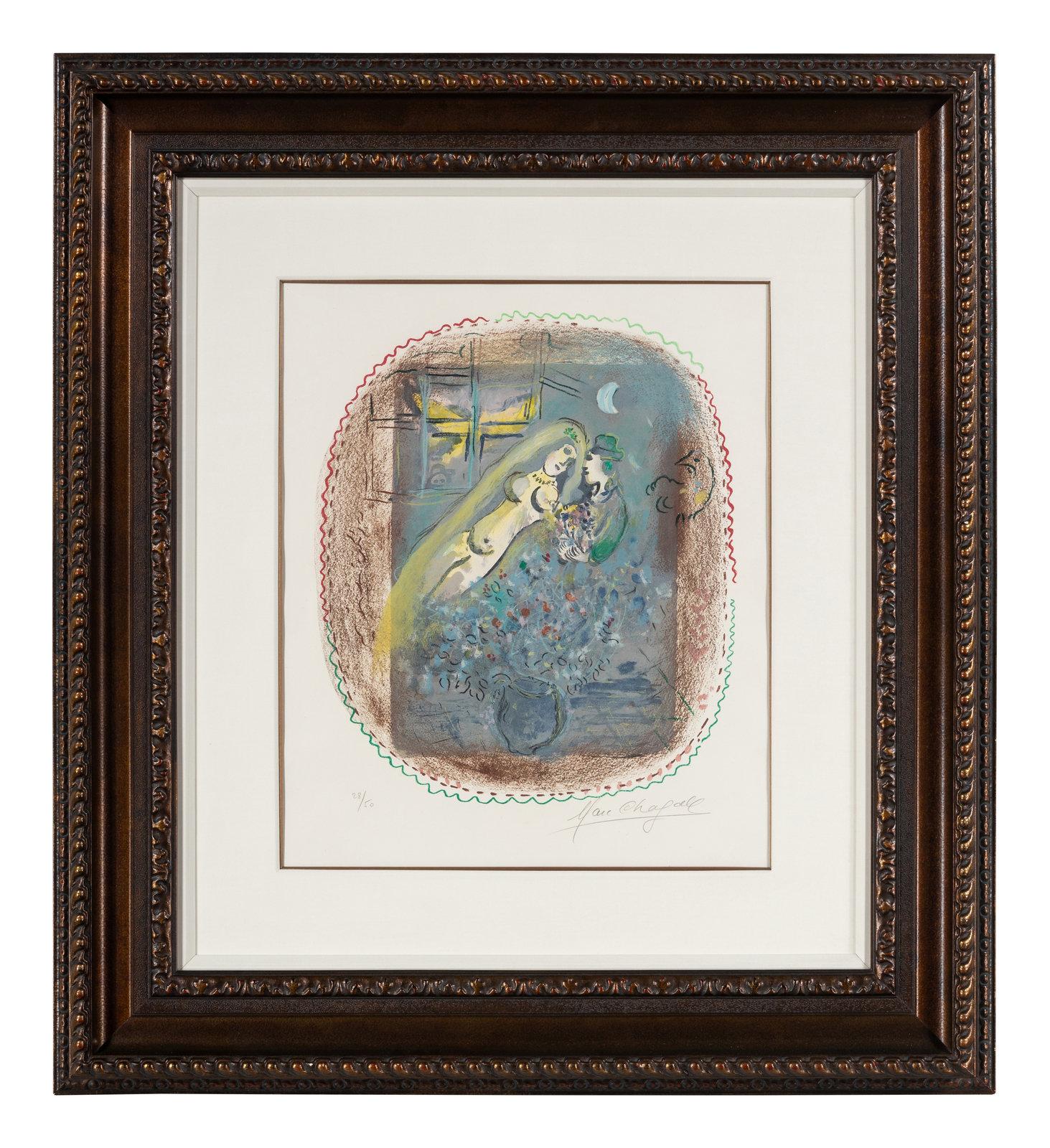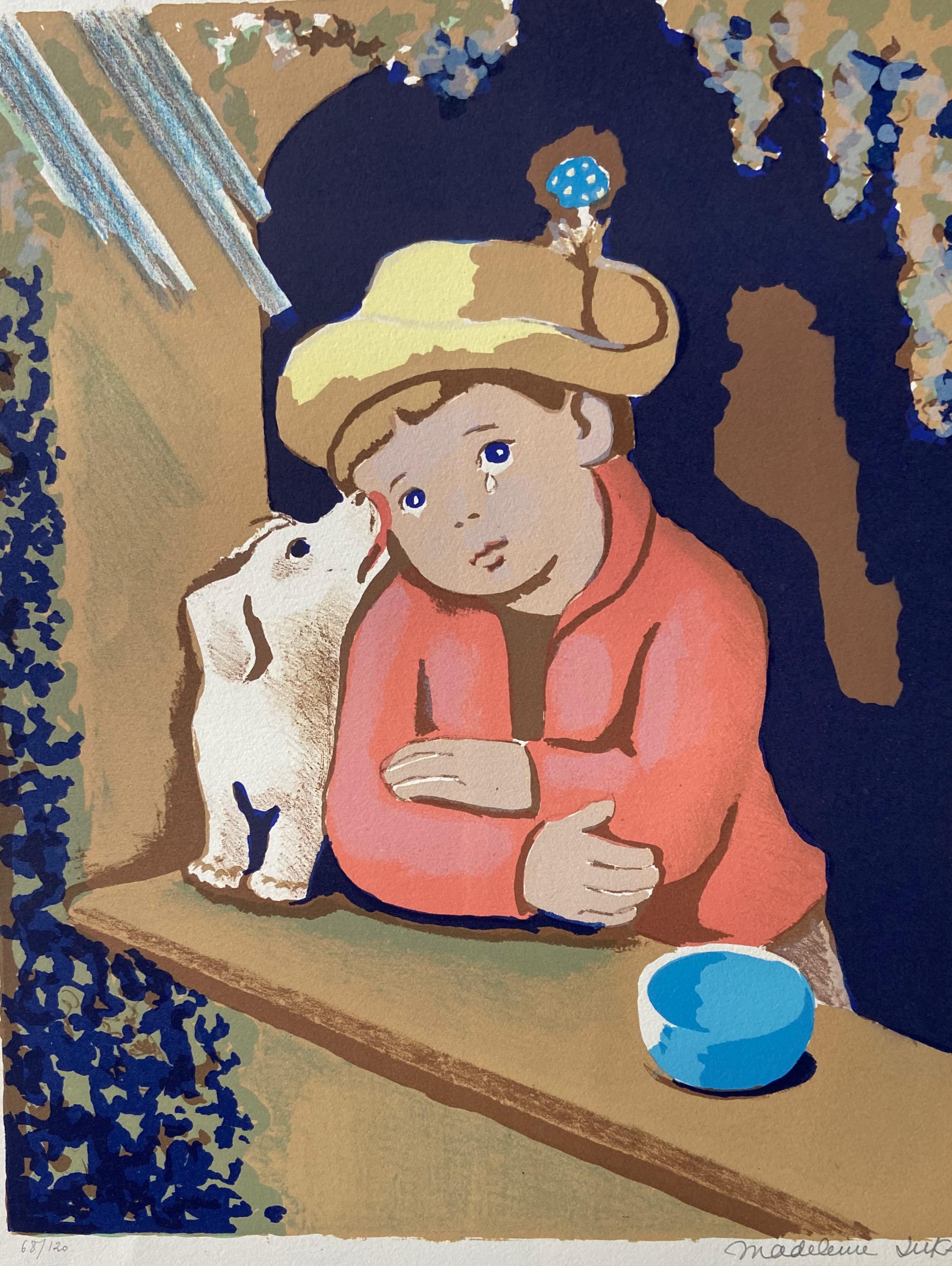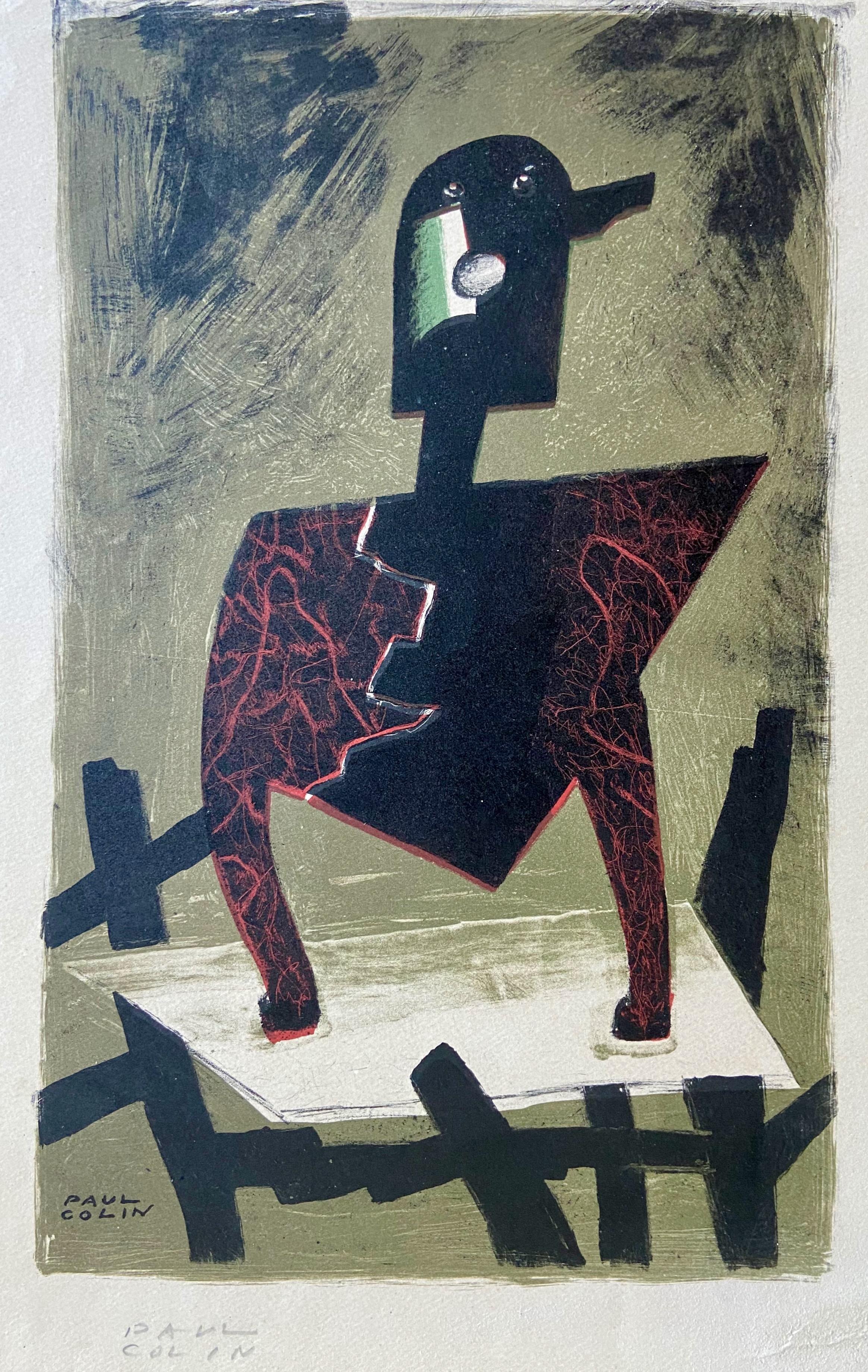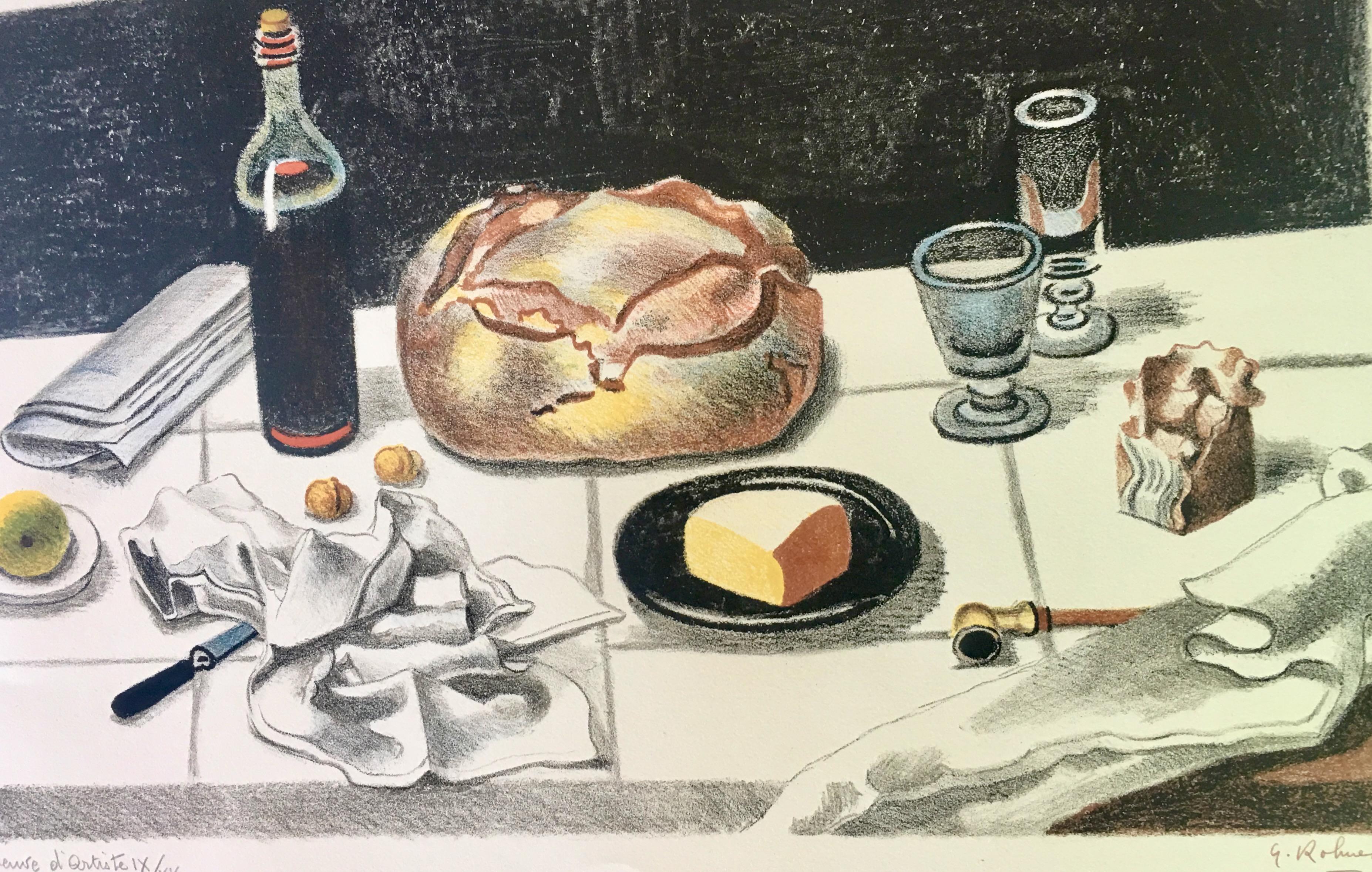Items Similar to "La Naissance D'Eve" from "Je Reve, " Color Lithograph signed by Andre Masson
Want more images or videos?
Request additional images or videos from the seller
1 of 8
André Masson"La Naissance D'Eve" from "Je Reve, " Color Lithograph signed by Andre Masson 1975
1975
About the Item
"La Naissance D'Eve" is an original color lithograph by Andre Masson. This piece, depicting Adam and Eve, is from Masson's "Je Reve (I Dream)" portfolio, and is signed in pencil lower right and edition XXII/XXV.
19 7/8" x 26" art
29 3/8" x 35 3/8" frame
André-Aimé-René Masson (4 January 1896 – 28 October 1987) was a French artist. Masson was born in Balagny-sur-Thérain, Oise, but was brought up in Belgium. He began his study of art at the age of eleven in Brussels, at the Académie Royale des Beaux-Arts under the guidance of Constant Montald, and later he studied in Paris.
His early works display an interest in cubism. He later became associated with surrealism, and he was one of the most enthusiastic employers of automatic drawing, making a number of automatic works in pen and ink. Masson would often force himself to work under strict conditions, for example, after long periods of time without food or sleep, or under the influence of drugs. He believed forcing himself into a reduced state of consciousness would help his art be free from rational control, and hence get closer to the workings of his subconscious mind. Masson experimented with altered states of consciousness with artists such as Antonin Artaud, Michel Leiris, Joan Miró, Georges Bataille, Jean Dubuffet, and Georges Malkine, who were neighbors of his studio in Paris.
By the end of the 1920s, however, he was finding Automatic drawing rather restricting, and he left the surrealist movement and turned instead to a more structured style, often producing works with a violent or erotic theme, and making a number of paintings in reaction to the Spanish Civil War.
Under the German occupation of France during World War II, his work was condemned by the Nazis as degenerate. With the assistance of Varian Fry in Marseille, Masson escaped the Nazi regime on a ship to the French island of Martinique from where he went on to the United States. Upon arrival in New York City, U.S. customs officials inspecting Masson's luggage found a cache of his erotic drawings. Denouncing them as pornographic, they ripped them up before the artist's eyes. Living in New Preston, Connecticut his work became an important influence on American abstract expressionists, such as Jackson Pollock. Following the war, he returned to France and settled in Aix-en-Provence where he painted a number of landscapes.
- Creator:André Masson (1896-1987, French)
- Creation Year:1975
- Dimensions:Height: 29.375 in (74.62 cm)Width: 35.375 in (89.86 cm)
- Medium:
- Movement & Style:
- Period:
- Condition:
- Gallery Location:Milwaukee, WI
- Reference Number:
About the Seller
4.9
Platinum Seller
These expertly vetted sellers are 1stDibs' most experienced sellers and are rated highest by our customers.
Established in 1966
1stDibs seller since 2017
390 sales on 1stDibs
Typical response time: 1 hour
- ShippingRetrieving quote...Ships From: Milwaukee, WI
- Return PolicyA return for this item may be initiated within 14 days of delivery.
More From This SellerView All
- "Le Bouquet tout fait (The Ready-made Bouquet), " Lithograph after Rene MagritteBy René MagritteLocated in Milwaukee, WI"Le Bouquet tout fait (The Ready-made Bouquet)" is a color lithograph after a 1954 original painting by Rene Magritte. A bourgeois "little man" faces away from the viewer looking towards a fall forest. Flora, the goddess of flowers and season of spring, from Sandro Botticelli's "Primavera" is painted on the back of the man. This juxtaposes fall and spring. Art: 12 x 9.75 in Frame: 22.38 x 20.38 in René-François-Ghislain Magritte was born November 21, 1898, in Lessines, Belgium and died on August 15, 1967 in Brussels. He is one of the most important surrealist artists. Through his art, Magritte creates humor and mystery with juxtapositions and shocking irregularities. Some of his hallmark motifs include the bourgeois “little man,” bowler hats, apples, hidden faces, and contradictory texts. René Magritte’s father was a tailor and his mother was a miller. Tragedy struck Magritte’s life when his mother committed suicide when he was only fourteen. Magritte and his two brothers were thereafter raised by their grandmother. Magritte studied at the Brussels Academy of Fine Arts from 1916 to 1918. After graduating he worked as a wallpaper designer and in advertisement. It was during this period that he married Georgette Berger, whom he had known since they were teenagers. In 1926, René Magritte signed a contract with the Brussels Art Gallery, which allowed him to quit his other jobs and focus completely on creating art. A year later he had his first solo show at the Galerie la Centaurie in Brussels. At this show Magritte exhibited what is today thought of as his first surrealist piece, The Lost Jockey, painted in 1926. In this work a jockey and his steed run across a theater stage, curtains parted on either side. Throughout the scene, there are trees with trunks shaped somewhat like chess pawns with musical scores running vertically up their sides and branches sticking out from all angles. Critics did not enjoy this style of art; it was new, different, and took critical thought to understand, but The Lost Jockey was only the first of many surrealist artworks Magritte would paint. Because of the bad press in Brussels, René and Georgette moved to Paris in 1927, with the hope that this center of avant-garde art would bring him success and recognition. In Paris, he was able to become friends with many other surrealists, including André Breton and Paul Éluard. They were able to learn from and inspire one another, pushing the Surrealist movement further forward. It was also in Paris that Magritte decided to add text to some of his pieces, which was one of the elements that made his artwork stand out. In 1929, he painted one of his most famous oil works: The Treachery of Images. This is the eye-catching piece centered on a pipe. Below the pipe is written “Ceci n’est pas un pipe,” which translates to “This is not a pipe.” This simple sentence upset many critics of the time, for of course it was a pipe. Magritte replied that it was not a pipe, but a representation of a pipe. One could not use this oil on canvas as a pipe, to fill it with tobacco and smoke it. Thus, it was not a pipe. In 1930, Magritte and Georgette moved back to Brussels. Though they would travel to his exhibitions elsewhere, their home going forward would always be in Brussels. Magritte had his first American exhibition at the Julien Levy Gallery in New York City in 1936 and his first show in England two years later in 1938 at The London...Category
2010s Surrealist Figurative Prints
MaterialsLithograph
- "La Reconnaissance Infinie (The Infinite Recognition)" Litho after Rene MagritteBy René MagritteLocated in Milwaukee, WI"La Reconnaissance Infinie (The Infinite Recognition)" is a color lithograph after the 1963 painting by Rene Magritte. Two of Magritte's bourgeois "little men" stand in the sky. Both look away from the viewer talking to each other in the typical outfit of Magritte's men, black trench coats and bowler hats. Art: 15 x 18.25 in Frame: 26.25 x 29.88 in René-François-Ghislain Magritte was born November 21, 1898, in Lessines, Belgium and died on August 15, 1967 in Brussels. He is one of the most important surrealist artists. Through his art, Magritte creates humor and mystery with juxtapositions and shocking irregularities. Some of his hallmark motifs include the bourgeois “little man,” bowler hats, apples, hidden faces, and contradictory texts. René Magritte’s father was a tailor and his mother was a miller. Tragedy struck Magritte’s life when his mother committed suicide when he was only fourteen. Magritte and his two brothers were thereafter raised by their grandmother. Magritte studied at the Brussels Academy of Fine Arts from 1916 to 1918. After graduating he worked as a wallpaper designer and in advertisement. It was during this period that he married Georgette Berger, whom he had known since they were teenagers. In 1926, René Magritte signed a contract with the Brussels Art Gallery, which allowed him to quit his other jobs and focus completely on creating art. A year later he had his first solo show at the Galerie la Centaurie in Brussels. At this show Magritte exhibited what is today thought of as his first surrealist piece, The Lost Jockey, painted in 1926. In this work a jockey and his steed run across a theater stage, curtains parted on either side. Throughout the scene, there are trees with trunks shaped somewhat like chess pawns with musical scores running vertically up their sides and branches sticking out from all angles. Critics did not enjoy this style of art; it was new, different, and took critical thought to understand, but The Lost Jockey was only the first of many surrealist artworks Magritte would paint. Because of the bad press in Brussels, René and Georgette moved to Paris in 1927, with the hope that this center of avant-garde art would bring him success and recognition. In Paris, he was able to become friends with many other surrealists, including André Breton and Paul Éluard. They were able to learn from and inspire one another, pushing the Surrealist movement further forward. It was also in Paris that Magritte decided to add text to some of his pieces, which was one of the elements that made his artwork stand out. In 1929, he painted one of his most famous oil works: The Treachery of Images. This is the eye-catching piece centered on a pipe. Below the pipe is written “Ceci n’est pas un pipe,” which translates to “This is not a pipe.” This simple sentence upset many critics of the time, for of course it was a pipe. Magritte replied that it was not a pipe, but a representation of a pipe. One could not use this oil on canvas as a pipe, to fill it with tobacco and smoke it. Thus, it was not a pipe. In 1930, Magritte and Georgette moved back to Brussels. Though they would travel to his exhibitions elsewhere, their home going forward would always be in Brussels. Magritte had his first American exhibition at the Julien Levy Gallery in New York City in 1936 and his first show in England two years later in 1938 at The London Gallery...Category
2010s Surrealist Figurative Prints
MaterialsLithograph
- "La Grande Guerre (The Great War), " Color Lithograph after Rene MagritteBy René MagritteLocated in Milwaukee, WI"La Grande Guerre (The Great War)" is a color lithograph after the 1964 painting by Rene Magritte. A Victorian lady stands in white facing the viewer. A bouq...Category
2010s Surrealist Figurative Prints
MaterialsLithograph
- "Vanity Fair (The Face Off) Recto, Camel Cigarette Verso, " by Paolo GarrettoBy Paolo GarrettoLocated in Milwaukee, WIThis double-sided lithograph by Paolo Garretto features a Vanity Fair cover "The Face Off" on the front and a Camel Cigarette ad on the back. It was pu...Category
1930s Surrealist Figurative Prints
MaterialsLithograph
- "A Multiple of Gaudy and Fantastic Appearances from Edgar Allen Poe..."By Federico CastellonLocated in Milwaukee, WI"A Multiple of Gaudy and Fantastic Appearances" from "Edgar Allen Poe's Mask of the Read Death" is an original lithograph by Frederico Castellon. The artist ...Category
1960s Surrealist Figurative Prints
MaterialsLithograph
- "La race blanche (The White Race), " Lithograph after Painting by Rene MagritteBy René MagritteLocated in Milwaukee, WI"La race blanche (The White Race)" is a color lithograph after the original 1937 painting by Rene Magritte. A female figure is made out of a mix of body parts. An eye sits on top of an ear, which is on top of a mouth, then two noses. Two breasts lying on a stomach; two arms come from the breasts. Legs are tucked under the stomach. This figure is on a sand dune next to the ocean. Art: 26.5 x 19.63 in Frame: 40.88 x 33.88 in René-François-Ghislain Magritte was born November 21, 1898, in Lessines, Belgium and died on August 15, 1967 in Brussels. He is one of the most important surrealist artists. Through his art, Magritte creates humor and mystery with juxtapositions and shocking irregularities. Some of his hallmark motifs include the bourgeois “little man,” bowler hats, apples, hidden faces, and contradictory texts. René Magritte’s father was a tailor and his mother was a miller. Tragedy struck Magritte’s life when his mother committed suicide when he was only fourteen. Magritte and his two brothers were thereafter raised by their grandmother. Magritte studied at the Brussels Academy of Fine Arts from 1916 to 1918. After graduating he worked as a wallpaper designer and in advertisement. It was during this period that he married Georgette Berger, whom he had known since they were teenagers. In 1926, René Magritte signed...Category
Early 2000s Surrealist Figurative Prints
MaterialsLithograph
You May Also Like
- "The Four Seasons" by Marc ChagallBy Marc ChagallLocated in Hinsdale, ILMARC CHAGALL The Four Seasons. Color lithograph, 1974. 940x640 mm; 37x26 inches (sheet), full margins. The deluxe edition of 100. Signed and numbered 65/100 in pencil, lower mar...Category
1970s Surrealist Figurative Prints
MaterialsLithograph
- Marc Chagall "Dédicace"By Marc ChagallLocated in Los Angeles, CAMarc Chagall (French/Russian, 1887-1985) "Dédicace" 1968 Color lithograph signed and numbered 28/50 in pencil Image: 17 7/8 x 15 1/4 inches. Framed: 38 x 34 1/4 x 2 1/4 inches. ...Category
Mid-19th Century Surrealist Figurative Prints
MaterialsLithograph
- Boy and puppyLocated in Belgrade, MTMadeline Luka (French 1894-1989) was a self taught painter known for her landscapes, portraits, nudes and still lifes. She typically portrayed her family and close friends set within...Category
Mid-20th Century Surrealist Figurative Prints
MaterialsLithograph
- untitled, originalBy Paul ColinLocated in Belgrade, MTThis piece is a limited edition, pencil signed by the artist on the print and in the plate. It is part of my private collection of artists from the School of Paris era. It is in very...Category
Mid-20th Century Surrealist Figurative Prints
MaterialsEngraving, Lithograph
- Nature morte still life, original lithographBy Georges RohnerLocated in Belgrade, MTGeorges Rohner ( French, 1913-2000)was a Paris born painter and printmaker of international repute. Known stylistically as a realist, his creative endeavors often edged toward surre...Category
Mid-20th Century Surrealist Still-life Prints
MaterialsLithograph
- Salvador Dali “Nightmare of Moses” Lithograph, Signed EditionBy Salvador DalíLocated in Lake Worth Beach, FLAdditional Information: Lithograph with etching is from the “Moses and Monotheism” suite published by the Salvador Dali Archives. Provenance: Sims Reed Gallery, London, UK | Russeck ...Category
1970s Surrealist Figurative Prints
MaterialsLithograph
Recently Viewed
View AllMore Ways To Browse
Andre Michel
Vintage Food Signs
Vintage Food Sign
Retro Food Sign
Eve France
French Fry
Expressionist Erotic Art
Paris Royale
1920s French Lithograph Framed
Jean Dubuffet Lithograph Signed
La Royale
Landscape Aix Provence
French Fries Vintage
Vintage Food Drawing
Vintage Food Drawings
Vintage 4 Color Pen
Preston And York
1920s Sleep
